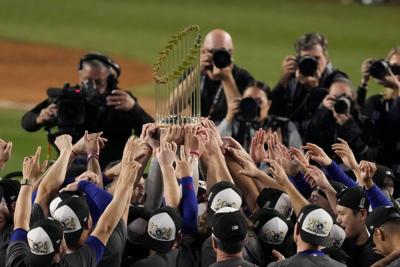
Members of the Los Angeles Dodgers, a team with a payroll of nearly $250 million, hoist the World Series trophy after winning it by beating the New York Yankees in Game 6 on Thursday, Oct. 31, 2024, in New York.Â
The idea of a pushbutton solution to fix the financial imbalance in Major League Baseball remains seductive to baseball fans. That certainly resonates in the middle of the country, away from the large market coastal cities like New York, Los Angeles, Philadelphia, Boston and San Francisco.
A salary cap certainly appears like a particularly enticing option, at least on the surface. However, it’s not the fool-proof solution some folks imagine.
The more the large market teams leverage their financial might to acquire high-profile talent, the more a salary cap looks like an open and shut case for fans of teams in smaller markets with more modest financial resources.
Even if trying to implement a salary cap wasn’t a recipe for a work stoppage. It likely is. Even if ownership in large markets accepted that it’s a wise move to redirect their revenue toward their competitors. Good luck with that. Even if players, who are under the thumb of MLB organizations throughout their minor-league careers and who have their salaries artificially restricted for the first six years of their major-league careers, agree to a cap. Why wouldn’t they swap the current restrictions in exchange for restrictions to what they can earn as free agents?
People are also reading…
Even if we enter this magical land of pixie dust, Tinker Bell and happy thoughts that make it possible to fly, the wizardry of a salary cap still has its own limitations.
We need only look to the other sports for proof.
After all, some of the myths that we associate with the idea of a salary cap include the idea that it will spread the wealth in terms of championships. It’s also going to assure that rich teams can’t continue to spend at a rate that makes other teams irrelevant. This system will prevent teams from stockpiling top talent just because they’ve got deeper pockets. Right?
Well, the NFL has a salary cap in place. The Chiefs, the reigning dynasty of the league, basically took the place of the previous dynasty put together by the New England Patriots. The Chiefs already have gone to four of the past five Super Bowls, won three of them, and they’ve got a chance to win a third in a row on Sunday. That’s after the Patriots won five in an eight-year period from 2011-18.
If you want to argue that those two are outliers and that the system has put a wider variety of teams in the running, well, then there’s the small matter of a handful of other teams making multiple appearances in a short period of time.
The Philadelphia Eagles will make their third Super Bowl appearance in eight years. The LA Rams went to two in four years (2018-21). The San Francisco 49ers went to two in five years. So it’s not just the Chiefs and Patriots that have worked the system to remain at the or near the top for an extended period of time.
The NBA provides a little bit better example of putting a championship in play for a larger number of franchises. Then again, the Boston Celtics have gone to two of the last three NBA Finals. The Golden State Warriors had a stretch in which they went to five straight, six in eight years and won four titles. While LeBron James isn’t a team by himself, his teams — the Miami Heat, Cleveland Cavalier and Los Angeles Lakers — played in the NBA Finals nine times in a 10-year period.
The NHL comes the closest to that ideal of you never know who will be left standing at the end. In the last 10 years, 13 franchises have been to the Stanley Cup Final. So that’s something. The Tampa Bay Lightning made four appearances in 10 years, but there’s still a variety of teams that have gotten to the doorstep of a championship.
Now, the Tampa Bay Lightning bring us to another issue. All of the current versions of salary caps have loopholes that teams exploit.
The Lightning drew the ire of hockey fans because they took advantage of the fact that a long-term injury designation prevented a player’s salary from counting against the cap. That led to some roster shenanigans that left the Lightning with a loaded roster, not subject to the salary cap, when the playoffs rolled around.
The NBA’s salary cap system has myriad of exceptions built into it. Plus, there are multiple thresholds that teams face penalties for surpassing. However, they still pass those thresholds. They pay a financial penalty, but they still end up with the players they want.
This week, former NBA executives Bobby Marks and Bob Myers stated on ESPN that they don’t know how the Golden State Warriors are going to navigate the potential luxury tax and salary apron ramifications going forward. Yet, the Warriors plowed ahead with a trade for Jimmy Butler and a contract extension as they kicked the can down the road.
NFL teams long ago made a mockery of that league’s salary cap by restructuring contracts, converting salary into signing bonuses, adding years to deals for the sole purpose of manipulating the salary cap’s impact and other such bookkeeping maneuvers.
This all, of course, doesn’t even factor in the notion that some players will simply go to certain cities or teams they like or choose to play with certain teammates and leave some money on the table in order to do so. A salary cap doesn’t stop that.
While fans aren’t crazy to wish for a salary cap, let’s keep in mind it may not be the cure all we hope.















